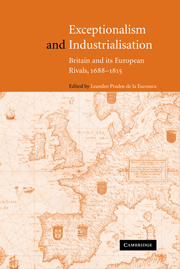Book contents
- Frontmatter
- Contents
- List of tables and figures
- List of contributors
- Acknowledgements
- Introduction: Was British industrialisation exceptional?
- Part I The origins of British primacy
- Part II Agriculture and industrialisation
- Part III Technological change
- Part IV Institutions and growth
- 8 The monetary, financial and political architecture of Europe, 1648–1815
- 9 Towards the comparative fiscal history of Britain and France during the ‘long’ eighteenth century
- 10 Money and economic development in eighteenth-century England
- Part V War and Hegemony
- Conclusions
- References
- Index
8 - The monetary, financial and political architecture of Europe, 1648–1815
Published online by Cambridge University Press: 04 December 2009
- Frontmatter
- Contents
- List of tables and figures
- List of contributors
- Acknowledgements
- Introduction: Was British industrialisation exceptional?
- Part I The origins of British primacy
- Part II Agriculture and industrialisation
- Part III Technological change
- Part IV Institutions and growth
- 8 The monetary, financial and political architecture of Europe, 1648–1815
- 9 Towards the comparative fiscal history of Britain and France during the ‘long’ eighteenth century
- 10 Money and economic development in eighteenth-century England
- Part V War and Hegemony
- Conclusions
- References
- Index
Summary
Among Patrick O'Brien's enduring contributions to the economic history of Britain is his work documenting the steady rise of central government taxation in the eighteenth century, even though Britain was already one of the highest-taxed economies in the world by 1688. While the successive rises in taxation, either by widening the tax base to include more sources of taxation or by increasing the rates of existing taxes, were clearly driven by the wars of the eighteenth century, the puzzle he put to the profession was, ‘How was the British government able to do this?’ The puzzle arose from the constraints placed upon the monarchy by an elected parliament that had complete control over tax policy and was loath to tax its members, comprised of landed gentry and wealthy burgers. Moreover, given the splendid isolation of Britain from the land mass of Europe and the professional armies that ranged over it from the fifteenth century on, it was never clear that Britain had to be committed to participation in any of the dynastic wars continually erupting on the continent. Provisionally, O'Brien and Mathias in an earlier article had suggested that the answer lay in Britain's increasing reliance upon indirect taxes, at least until the imposition of the income tax by Pitt the Younger in 1799. Until the threat of French domination of the continent motivated the British ruling classes to tax themselves, they argued, excise taxes were the tax of choice, rather than customs revenues.
- Type
- Chapter
- Information
- Exceptionalism and IndustrialisationBritain and its European Rivals, 1688–1815, pp. 173 - 190Publisher: Cambridge University PressPrint publication year: 2004
- 3
- Cited by

